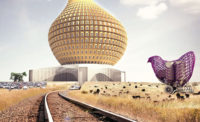For the Biennial, CAMESgibson, along with Skidmore, Owings & Merrill, has designed a high-rise that aims to house middle-class people. “Many of the current methods of producing multifamily housing result in super-high-end units or mass-produced towers for the working poor. We want to develop a prototype with a flexible design that would allow residents to live there for their entire lives,” says Gibson. The building’s core would be publicly owned and maintained rather than considered a part of the building. “Our thought is that if we turn the core over to municipalities, privatization will take place only at the unit level, allowing owners the freedom to customize their spaces as they please.”
With a rotating cast of interns, CAMESgibson also undertakes built work, including a new wing for the Hyde Park Art Center that contains shared studio suites, with event spaces at either end. “The center is amping up its commitment to local up-and-coming artists,” notes Gibson.



